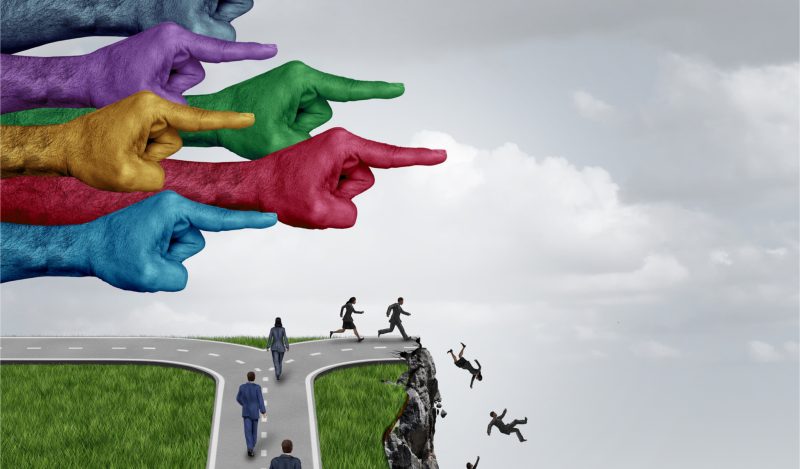Totalitarianism isn’t something that happens to other countries, those less fortunate or less civilized or a few times in our own shameful history. It’s a constant travel companion in a technocratic society that overvalues rationality and believes oneself capable of steering that which will not be steered. It is usually suppressed and kept well-controlled, yet always lurking beneath the surface of even the friendliest of populations.
The fascinating and terrifying thing about totalitarian regimes isn’t the horrific deeds they commit – mere dictatorships and warlords and psychopaths are fully capable of that too. Instead, as Hannah Arendt so forcefully explored, it’s that their overwhelming ideological control seeps into every fabric of society. It’s the fervor with which neighbor turns on neighbor, and friends and family members happily denounce trespasses of the stated dogma.
Nobody really seems in control of whatever force is pulling it forward and usually nobody is pulling corrupt, invisible strings: everyone is enchanted by the ideological spell under which they all operate. Once an avalanche has begun tumbling down the mountain, it exerts the most unstoppable of forces.
The collective hums together and upholds the rules, no matter how insane or ineffective at achieving their supposed aim. Totalitarianism is the blurring of fact and fiction, yet with an aggressive intolerance for diverging opinions. One must toe the line.
In his new book The Psychology of Totalitarianism, which comes out in an English translation this month, Belgian psychologist Mattias Desmet calls this phenomenon “mass formation.” He writes that he first began sketching on a comprehensive account of totalitarianism in 2017: woke culture and the intolerant anxiety that came with its rise to power was a symptom – as was the surveillance state and the hysteria in recent decades surrounding terrorism and climate change.
It’s not the topics themselves or the merits of their respective case that interests Desmet, but the way populations process them, get wrapped up in them, and psychologically attach themselves to their ideas.
Ultimately, it was the reactions to the coronavirus events in 2020 that was Desmet’s ultimate catalyst. It shone a bright light on many things that, beyond a doubt, had gone wrong with modern society. Here was mass formation, on full display; totalitarian behavior, suddenly lived and experienced by all of us.
In essence, mass formation is a sort of group-level hypnosis “that destroys individuals’ ethical self-awareness and robs them of their ability to think critically.” Labor camps and mass extermination, so unknown and so unfathomable to our delicate present, don’t come out of nowhere but “are merely the final, bewildering stage of a long process.”
The coronavirus crisis didn’t come out of the blue, either; we made it. (We probably made the virus too, but that’s not the object of Desmet’s investigation.) “Totalitarianism is not a historical coincidence,” he writes, “In the final analysis, it is the logical consequence of mechanistic thinking and the delusional belief in the omnipotence of human rationality.”
He traces the inevitability of knee-jerk totalitarian reactions all the way to Enlightenment attachment to rationality and control – with totalitarianism being “the defining feature of the Enlightenment tradition.” The other key ingredients to unravel the mysteries of the last two years are:
- Generalized loneliness, social isolation, or a lack of social bonds. Hannah Arendt, in trying to make sense of the tyrannical regimes of the 20th century, wrote that “the chief characteristic of the mass man is not brutality and backwardness, but his isolation and lack of normal social relationships.”
- Lack of meaning in life, best illustrated by the insane rise of bullshit jobs, per David Graeber: plenty of people devote their everyday lives to doing things that, by their own accord, are useless, wasteful, or pointless. Social alienation of the creator from both his product and his customer.
- Free-floating anxiety: a society with lots of anxiety that isn’t bound up with specific objects, like fear of snakes or war (or perhaps anxiety before invisible enemies – like climate change or the patriarchy). The WHO repeatedly says that something like one in five adults have been diagnosed with an anxiety disorder; antidepressants consumed like they’re chewing gum.
- Frustration and aggression: there’s a clear link between people who are lonely, lack meaning in life, suffer from anxiety and the tendency to lash out at others – irritation, insults, and the blame game played in full purview.
Desmet writes,
“What accelerates mass formation is not so much the frustration and aggression that are effectively vented, but the potential of unvented aggression present in the population—aggression that is still looking for an object.”
That we didn’t exactly live in a healthy society on the eve of the pandemic probably doesn’t come as a surprise to anyone – everything from homelessness, a mental health disaster and an opioid epidemic, racial tensions, corruption, and the culture wars to the unmistakable size of the average American’s waist screamed “emergency.”
Using these ingredients, Desmet weaves a story that tries to make sense of the extraordinary behavior that dominated 2020 and 2021, both in the very aggressive public discourse over what to do and who to blame, and the even more aggressive stance that everyone experienced in private interactions with one another.
Desmet’s take, following Hannah Arendt (a hero for political theorists, particularly on the left), shows that opposition to coronavirus measures isn’t merely the mad ramblings of a right-wing fringe. Opposing the public measures taken in 2020 and 2021 crossed political lines, and the components of his argument are, if anything, more traditionally associated with values and worries on the left: loneliness, social isolation, atomized individuals, unseen collateral damage, bullshit jobs and rejection of the technocratic Enlightenment view of top-down rational control and scientific improvement.
The stunning question looms: how do we make sense of all of this? We overhauled society, on a whim and with very little to go on, for what seemed – both at the time and in hindsight – a rather minor threat. How did we all lose our minds at the same time? How could we all feel such incredible buy-in in the months and years that followed?
Think, Desmet asks us, of a crowd singing together at a football stadium:
“The voice of the individual dissolves into the overwhelming, vibrating group voice; the individual feels supported by the crowd and ‘inherits’ its vibrating energy. It doesn’t matter what song or lyrics are sung; what matters is that they are sung together.”
Left or right, rich or poor, Black or white, Asian or Latino, in the spring of 2020 we were all suddenly in it together. What was on our minds before were suddenly swept away, and there was one thing that dominated everyone’s attention – a trigger for mass formations, merging every disparaging conflict into a mesmerizing unity.
Mass formation is the highest form of collectivism, a sense of mythical belonging that those fascinated by groups rather than individuals have routinely(?) labeled “society,” “solidarity” or “democracy.”
“What one thinks does not matter; what counts is that people think it together. In this way, the masses come to accept even the most absurd ideas as true, or at least to act as if they were true.”
If, at the same time, a “suggestive” story
“offers a strategy to deal with that object of anxiety, there is a real chance that all the free-flowing anxiety will attach itself to that object and there will be broad social support for the implementation of the strategy to control that object of anxiety […] The fight against the object of anxiety then becomes a mission, laden with pathos and group heroism.”
“In this fight all latent brewing frustration and aggression is taken out, especially on the group that refuses to go along with the story and the mass formation.”
We can all think of events in the past years that fit these descriptions. People in our midst who became mesmerized by the covid outbreak to the point of obsession: they followed the CNN death count diligently, upheld the stated rules religiously, and punished any deviants or critics. The anger with which individuals acted seemed wholly at odds with any interpretation of the facts: What is driving this compulsive behavior?
This is precisely Desmet’s point: mass formation is associated with – almost requires – a blurring of the line between fact and fiction: The story matters; The in-group belonging matter. Whether the stated goal is desired or whether the actions taken towards it makes any sort of sense or could at all further the stated goal, is beside the point. “In all major mass formations, the main argument for joining in is solidarity with the collective. And those who refuse to participate are typically accused of lacking solidarity and civic responsibility” – thus, all the accusations of wanting grandma dead and sacrificing the elderly.
Desmet does all this without recourse to much smoking-gun type evidence or what passes for statistical analysis – the value of which he spends a surprising amount of time rebutting. The power of “metrics” can be deceiving, wielded to impress an impressionable mind (the “Science” says…); and not even the physical universe is as real and objective as we’re prone to think.
Ultimately, the value of his incredibly well-written prose comes down to whether you believe that this story fits the events of recent years, qualitatively and structurally speaking. He comes closer to that goal when he makes direct comparisons to the most pernicious and well-known mass formation in modern times, Nazi Germany – but surely, asks the skeptic, that’s too much…? We weren’t all brainwashed Nazis last year, were we? Nazi Germany tried to control, limit, and exterminate people they deemed unfit; we merely tried to control, limit and exterminate a virus.
So, who’s to blame? As with any complex phenomenon in nature or in human affairs – probably nobody… or everybody? “Mass formation takes both victims and perpetrators in its grip.” There isn’t, contrary to conspiracy theories of Great Resets or the Plandemic, a malicious elite in control of a totalitarian system that brainwashed an innocent and unsuspecting populace. Rather, it’s “the stories and their underlying ideology; these ideologies take possession of everyone and belong to no one; everyone plays a part, nobody knows the full script.”
We don’t get many solutions, and the overarching explanation that holds the somewhat metaphysical account together is the immune-suppressing power of stress and anxiety. Stressed bodies are physically less resistant to viruses. Nocebo and Placebo effects rule.
What effectively dispels the dream-like stance of mass formation is opposition. You have to speak up: “everyone who, in his own way, speaks out about the truth, contributes to the cure of the ailment that is totalitarianism.”
Unfortunately, speaking out also puts a target on your back: you may be obliged in some cosmic sense to speak up against untruth and madness, but are you therefore obliged to become a martyr? Luckily, Desmet also offers us the opposite route from speaking up: endure. It is okay also not to speak up because the most important thing is to survive until the totalitarian system has destroyed itself: a totalitarian system is self-destructive and “doesn’t have to be overcome so much as one must somehow survive until it destroys itself.”
The covid pandemonium was a reminder that even rich, sensible, well-mannered, and well-educated societies can descend into the pits of hell faster than you can cry “emergency.” Society always balances on the edge of an unspeakably horrific abyss.
For those of us scratching our heads in disbelief at what happened in 2020 and 2021, Desmet’s book comes up short. It’s not as comprehensive and conclusive as we might have liked, and it definitely won’t be the final word on this strange episode. Still, it offers us a plausible story, nested in the ways that the human mind can collectively go astray.
Join the conversation:


Published under a Creative Commons Attribution 4.0 International License
For reprints, please set the canonical link back to the original Brownstone Institute Article and Author.









